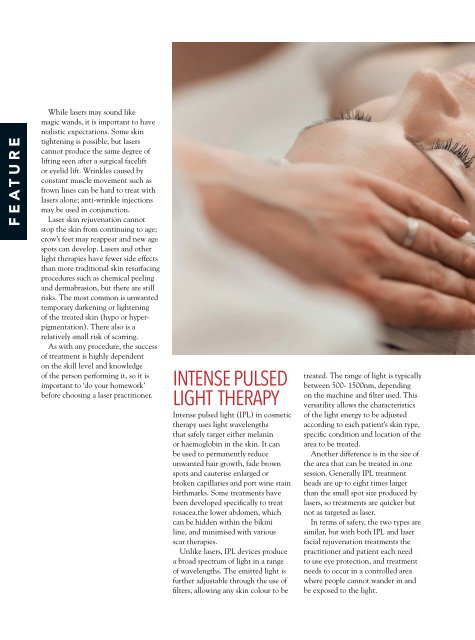CosBeauty Magazine #84
CosBeauty is the #BeautyAddict's guide to lifestyle, health and beauty in Australia. In this issue: - Celebrity Trend Spotting - Mother's Day Gift Guide - Winter Skin Saviours - Pregnant? What products are safe to use - About Face; Rejuvenation with lasers and injectables
CosBeauty is the #BeautyAddict's guide to lifestyle, health and beauty in Australia.
In this issue:
- Celebrity Trend Spotting
- Mother's Day Gift Guide
- Winter Skin Saviours
- Pregnant? What products are safe to use
- About Face; Rejuvenation with lasers and injectables
Create successful ePaper yourself
Turn your PDF publications into a flip-book with our unique Google optimized e-Paper software.
feature<br />
While lasers may sound like<br />
magic wands, it is important to have<br />
realistic expectations. Some skin<br />
tightening is possible, but lasers<br />
cannot produce the same degree of<br />
lifting seen after a surgical facelift<br />
or eyelid lift. Wrinkles caused by<br />
constant muscle movement such as<br />
frown lines can be hard to treat with<br />
lasers alone; anti-wrinkle injections<br />
may be used in conjunction.<br />
Laser skin rejuvenation cannot<br />
stop the skin from continuing to age;<br />
crow’s feet may reappear and new age<br />
spots can develop. Lasers and other<br />
light therapies have fewer side effects<br />
than more traditional skin resurfacing<br />
procedures such as chemical peeling<br />
and dermabrasion, but there are still<br />
risks. The most common is unwanted<br />
temporary darkening or lightening<br />
of the treated skin (hypo or hyperpigmentation).<br />
There also is a<br />
relatively small risk of scarring.<br />
As with any procedure, the success<br />
of treatment is highly dependent<br />
on the skill level and knowledge<br />
of the person performing it, so it is<br />
important to ‘do your homework’<br />
before choosing a laser practitioner.<br />
intense pulsed<br />
light therapy<br />
Intense pulsed light (IPL) in cosmetic<br />
therapy uses light wavelengths<br />
that safely target either melanin<br />
or haemoglobin in the skin. It can<br />
be used to permanently reduce<br />
unwanted hair growth, fade brown<br />
spots and cauterise enlarged or<br />
broken capillaries and port wine stain<br />
birthmarks. Some treatments have<br />
been developed specifically to treat<br />
rosacea.the lower abdomen, which<br />
can be hidden within the bikini<br />
line, and minimised with various<br />
scar therapies.<br />
Unlike lasers, IPL devices produce<br />
a broad spectrum of light in a range<br />
of wavelengths. The emitted light is<br />
further adjustable through the use of<br />
filters, allowing any skin colour to be<br />
treated. The range of light is typically<br />
between 500- 1500nm, depending<br />
on the machine and filter used. This<br />
versatility allows the characteristics<br />
of the light energy to be adjusted<br />
according to each patient’s skin type,<br />
specific condition and location of the<br />
area to be treated.<br />
Another difference is in the size of<br />
the area that can be treated in one<br />
session. Generally IPL treatment<br />
heads are up to eight times larger<br />
than the small spot size produced by<br />
lasers, so treatments are quicker but<br />
not as targeted as laser.<br />
In terms of safety, the two types are<br />
similar, but with both IPL and laser<br />
facial rejuvenation treatments the<br />
practitioner and patient each need<br />
to use eye protection, and treatment<br />
needs to occur in a controlled area<br />
where people cannot wander in and<br />
be exposed to the light.


















